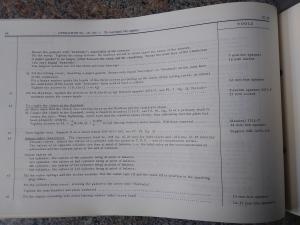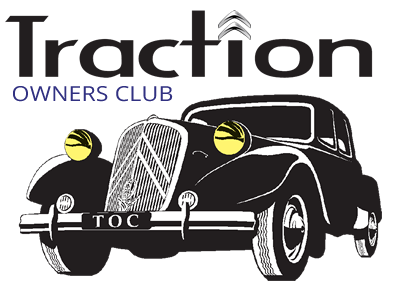Clutch Adjustment
Traction Owner’s Club › Forums › Technical › Gearbox & drive shafts › Clutch Adjustment
- This topic has 9 replies, 3 voices, and was last updated 4 years, 6 months ago by Bernie.
-
AuthorPosts
-
4th September 2019 at 1:46 am #25491
Christopher Smith
1951 L15 with 9 spring clutch Can anyone advise /direct me to texts on setting the correct height for the toggle levers
Being in NZ I of course don’t have access to any of the fancy tools shown in the manual Thanks Chris
4th September 2019 at 9:50 am #25493Bernie
ParticipantChris,
As you make reference to “the fancy tools shown in the manual” I assume you do have a copy of said tome. (If not it can be downloded from the technical pages).
The book shows 2 methods. The first (plate 24 in the drawings section) does indeed require some (relatively) sophisticated equipment but the second – plate 24a – is aimed at those who do not have that apparatus readily available.
You will see it does require the manufacture of three simple blocks and recommends using a surface plate. Any competent machine shop will be able to manufacture these blocks from the fully dimensioned drawing given. I had a set made some thirty years ago, and in addition to the numerous times I have used them myself, they have since been borrowed by a number of other owners as they cost little to post (within the UK). I would be most surprised if nobody in NZ has already made a set which they would be prepared to lend/hire to you.
However, if you do need to have a set made locally I am sure the cost which will not break the bank – and then you can hire them out!
Prior to obtaining a wonderful surface plate from a garage that was closing down, I always used a good quality mirror for the flat surface but a piece of float glass will be equally serviceable – the thicker the better to minimise distortion under the weight of the clutch components.
I hope this helps.
B……………….
4th September 2019 at 10:04 pm #25497Christopher Smith
Thanks Bernie . Sound advice and I will enquire from the local scene – someone might have a set of “blocks” Cheers Chris
6th April 2021 at 7:00 pm #28130Alain Sauvage
ParticipantI was keen to have ago at toggle adjustment but the advice line said I would be better off taking it to a clutch specialist. I have a 1955 11C with 4 cyclinder performa engine, the cluch friction plate and flywheel has been rectified, and reassembled with fresh springs, spacer washers, toggle bolts washers and nuts. Is there any specific information I need to give to the clutch centre or will they just know what to set it at? Thanks regards Alain
7th April 2021 at 10:46 pm #28140Bernie
ParticipantA reputable organisation is likely to be fully genned-up but I would suggest you offer them a copy of the relevant info from tbe manual.
B…..
8th April 2021 at 10:13 pm #28141Christopher Smith
Hi Chris from New Zealand replying A few of us have done it this way . Bolt the pressure plate to the flywheel using a 11 m spacer plate then set the toggle levers according to the diagram .It worked for me
5th June 2021 at 4:17 pm #28415Alain Sauvage
ParticipantThank you Chris and Bernie. I am starting to reassemble but have a question. When the flywheel was removed I noted it was secured in place with 6 15mm bolts no lock plate or lock washers to be seen. The parts manual has a lock plate in the pictures, is this required for the reassembly in this 1955 ID 19-P?
Thanks.
5th June 2021 at 7:29 pm #28416Bernie
ParticipantAlain,
Do you know anybody with an original spare parts catalogue? Unfortunately, I do not have the spares book but I do have a manual for the ID. See operation 41 in the relevant page from the ID workshop manual ………

This clearly says no “lock washers” and does not mention a plate.
I must admit I am surprised because the “11D” Traction engines definitely had a one piece “amoeba” locking plate for those screws.
Personally, I think I would want to fit one on an engine destined for a Light 15 – it can surely do no harm and could save a lot of long-term grief.
B….
- This reply was modified 4 years, 6 months ago by Bernie.
16th June 2021 at 10:34 am #28449Alain Sauvage
ParticipantThank you Bernie, I have obtained a lock plate but it sits proud of the fly wheel as the crank is not recessed. I might need to cut a bearing size hole in the middle. Your phot was helpful as it specifies torquing it to 36 lb which is almost double that in my 1938 to 1950 12/15 repair manual. It is possible with these later tractions that it was set to 36 lb.
16th June 2021 at 12:35 pm #28450Bernie
ParticipantAlain,
Proud? How much? Is it simply held off by the bearing?
I need to check but, if memory serves me correctly, the locking plate is formed to allow the bearing to protrude a couple of mm from the flywheel and the plate then also serves to retain the bearing. Cutting a “bearing size” hole would defeat that object.
B….
-
AuthorPosts
- You must be logged in to reply to this topic.
